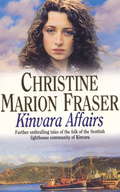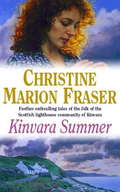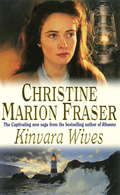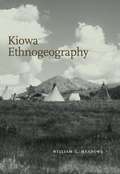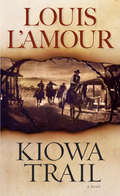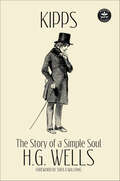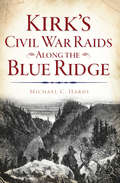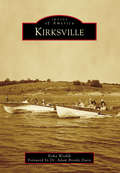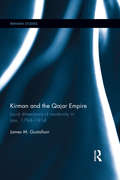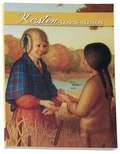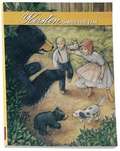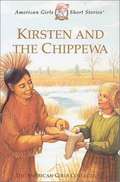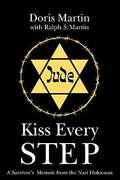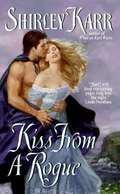- Table View
- List View
Kinvara Affairs
by Christine Marion FraserIt is 1936 and the children of Kinvara are growing up fast. Vaila Sutherland, a born romantic, vows she will never marry until she finds a love as deep as her father's for her mother. Two young men make a play for her heart - will she choose the right one?Andy Sutherland, Vaila's half brother, finds new doors opening despite the cerebral palsy that he has suffered since birth; while nine-year-old Essie, the joy of her mother's life, revels in a world of make-believe and wonder. Cruel Joshua Bowman continues his reign of terror but, as they grow up, his children find ways of thwarting his wishes. When Miriam, too, at last defies him, it has tragic consequences.Heartbreak and horror mingle with tears of joy and, as always, the villagers fight and laugh their way through this enchanting novel, adding many colourful contributions in their unique and inimitable way.'Christine Marion Fraser writes characters so real they almost leap out of the page...you would swear she must have grown up with them' Sun
Kinvara Affairs
by Christine Marion FraserIt is 1936 and the children of Kinvara are growing up fast. Vaila Sutherland, a born romantic, vows she will never marry until she finds a love as deep as her father's for her mother. Two young men make a play for her heart - will she choose the right one?Andy Sutherland, Vaila's half brother, finds new doors opening despite the cerebral palsy that he has suffered since birth; while nine-year-old Essie, the joy of her mother's life, revels in a world of make-believe and wonder. Cruel Joshua Bowman continues his reign of terror but, as they grow up, his children find ways of thwarting his wishes. When Miriam, too, at last defies him, it has tragic consequences.Heartbreak and horror mingle with tears of joy and, as always, the villagers fight and laugh their way through this enchanting novel, adding many colourful contributions in their unique and inimitable way.'Christine Marion Fraser writes characters so real they almost leap out of the page...you would swear she must have grown up with them' Sun
Kinvara Summer
by Christine Marion FraserIt is 1931 and the villagers of Kinvara are welcoming newcomers into their close-knit community. Schoolteacher Catherine Dunbar takes a great interest in the welfare and education of Andy Sutherland, who has cerebral palsy - and comes to have more than a passing interest in his father, Rob. Joshua Bowman is a less popular arrival, as he tries to force his strict principles and beliefs on his neighbours; and his wife Miriam - a native of Kinvara - has a dramatic effect on Johnny Lonely, to whom she was once married.But it is mainly on the children of Kinvara that the novel focuses, as they delight in the freedom and adventure of the beautiful coastal area, and grapple with the first stirrings of young and innocent love.'Christine Marion Fraser writes characters so real they almost leap out of the page...you would swear she must have grown up with them' Sun
Kinvara Summer
by Christine Marion FraserIt is 1931 and the villagers of Kinvara are welcoming newcomers into their close-knit community. Schoolteacher Catherine Dunbar takes a great interest in the welfare and education of Andy Sutherland, who has cerebral palsy - and comes to have more than a passing interest in his father, Rob. Joshua Bowman is a less popular arrival, as he tries to force his strict principles and beliefs on his neighbours; and his wife Miriam - a native of Kinvara - has a dramatic effect on Johnny Lonely, to whom she was once married.But it is mainly on the children of Kinvara that the novel focuses, as they delight in the freedom and adventure of the beautiful coastal area, and grapple with the first stirrings of young and innocent love.'Christine Marion Fraser writes characters so real they almost leap out of the page...you would swear she must have grown up with them' Sun
Kinvara Wives
by Christine Marion FraserStill wounded by her husband's affair with Morna Jean Sommero - an affair ended only by Morna Jean's tragically early death - Hannah Sutherland struggles to make a life for herself in Kinvara's close-knit community. At least she is coming to terms with the fact that her son, Andy, suffers from cerebral palsy, and is learning to love the boy despite his disability. The rugged beauty of the coast is a comfort and solace to Hannah, but can she reconcile herself to the fact that to Rob, she's always been second best and probably always would be.'Christine Marion Fraser writes characters so real they almost leap off the page...you would swear she must have grown up with them' Sun
Kinvara Wives
by Christine Marion FraserStill wounded by her husband's affair with Morna Jean Sommero - an affair ended only by Morna Jean's tragically early death - Hannah Sutherland struggles to make a life for herself in Kinvara's close-knit community. At least she is coming to terms with the fact that her son, Andy, suffers from cerebral palsy, and is learning to love the boy despite his disability. The rugged beauty of the coast is a comfort and solace to Hannah, but can she reconcile herself to the fact that to Rob, she's always been second best and probably always would be.'Christine Marion Fraser writes characters so real they almost leap off the page...you would swear she must have grown up with them' Sun
Kiowa County
by Kiowa County Historical Society Project, Eads High School Local HistoryCarved out of Bent County in 1889, Kiowa County is a rural, agricultural area with a rich and varied history. Located in southeastern Colorado in the heart of the Great Plains, Kiowa County was originally dominated by cattle ranches; however, farming quickly became just as important. The construction of the Missouri Pacific Railroad in the late 1880s sparked the growth of towns in Kiowa County, bringing a variety of ambitious settlers facing many challenges. Confronted with a well-documented drought cycle in the semiarid climate, the settlers persevered to establish schools and businesses and to create homes. Although Kiowa County never became home to a booming metropolis as early residents dreamed, the county's citizens take pride in a rich history and strive to preserve it.
Kiowa Ethnogeography
by William C. MeadowsExamining the place names, geographical knowledge, and cultural associations of the Kiowa from the earliest recorded sources to the present, Kiowa Ethnogeography is the most in-depth study of its kind in the realm of Plains Indian tribal analysis. Linking geography to political and social changes, William Meadows applies a chronological approach that demonstrates a cultural evolution within the Kiowa community. Preserved in both linguistic and cartographic forms, the concepts of place, homeland, intertribal sharing of land, religious practice, and other aspects of Kiowa life are clarified in detail. Native religious relationships to land (termed "geosacred" by the author) are carefully documented as well. Meadows also provides analysis of the only known extant Kiowa map of Black Goose, its unique pictographic place labels, and its relationship to reservation-era land policies. Additional coverage of rivers, lakes, and military forts makes this a remarkably comprehensive and illuminating guide.
Kiowa Trail
by Louis L'AmourKate Lundy, owner of the Tumbling B, and Conn Dury, her foreman, told Tom the rules: men from the cattle drives are forbidden on the north side of town. People appreciated the money the cowboys spent but thought them too coarse to be near their homes. Enticed to come calling by Linda McDonald, daughter of one of the leading citizens, Tom Lundy broke the law and crossed the line. Later that night, he was dead. Outraged by her brother's murder, Kate vows to destroy the entire town. But when Aaron McDonald sends east for an army of hired guns, Conn Dury and the men of the Tumbling B soon wonder if the price of Kate's revenge is too high.From the Paperback edition.
Kipps: The Story of a Simple Soul
by H.G. WellsThe most successful mainstream novel of H.G. Wells, now finally back in print. Kipps The Story of a Simple Soul Until he reached manhood, it was not clear to Kipps how he came to be under the care of an aunt and uncle, instead of having a father and mother like other little boys. But the elusive memories of his phantom mother that plagued him began to fade away over time. His life’s memories begin to be filled with childhood friendship and love, until that too was taken away. Now, after coming into an unsuspected inheritance, Kipps tries to adapt to a new social life, one that challenges him in a way he didn’t expect. With money and newfound love, one might think that Kipps would be on top of the world, but he soon finds out that he was better off without it… Long unavailable to readers, Kipps is a classic rags-to-riches story that addresses the moral and emotional difficulties that come with wealth and a change of social station. It will make you think, have you laughing, and capture your heart.
Kirk on the Zambesi: A Chapter Of African History
by Sir Reginald CouplandOriginally published in 1928, this book forms an excellent and detailed account of the Zambesi Expeditions of 1858-63. The book is based mainly on the daily journal kept by Sir John Kirk, Livingstone's lieutenant on the Expedition. It contains much material which was not given to the public in Livingstone's description. Kirk was one of the first explorers to carry a camera, and the book is illustrated from his own photographs.
Kirk's Civil War Raids Along the Blue Ridge (Civil War Series)
by Michael C. HardyIn the Southern Appalachian Mountains, no character was more loved or despised than Union officer George W. Kirk. He led a group of deserters on numerous raids between Tennessee and North Carolina in 1863. At Camp Vance in Morganton, Kirk's mounted raiders showcased guerrilla warfare penetrating deep within Confederate territory. As Home Guards struggled to keep Western North Carolina communities safe, Kirk's men brought fear throughout the region for their ability to strike and create havoc without warning. Civil War historian Michael C. Hardy examines the infamous history of George W. Kirk and the Civil War along the Blue Ridge.
Kirkby's Changeling
by Madeleine BrentWhen eighteen year-old Chantal first encounters the half-starved tramp who calls himself Martin, she is touring Hungary with a circus company as one of the 'Flying Gallettis', and prefers to forget every detail of her unhappy early years in faraway England. But a train of events is started which will bring her inevitably back to her destiny and to the unravelling of many mysteries that surround her life. Who is this Martin, who speaks like an English gentleman and looks like a tinker? Why is he in Hungary at all? Whose powerful malice has pursued her since childhood, and why? Who indeed is she? In Chantal Madeleine Brent has created one of her most appealing characters. Red-haired and spirited, her wilfulness and courage win hearts and bring trouble upon her wherever she goes, but although she has driven herself unsparingly to attain a rare skill as a circus artist, her true ambition is to become a doctor (no mean aspiration at the beginning of this century). The story moves from the warm, bustling atmosphere of a travelling circus to the cold correctness of English country house society, and back again to Eastern Europe, before all the complex strands are finally unravelled. Packed with incident and excitement, Kirkby's Changeling represents Madeleine Brent at her very best.
Kirksville
by Erika WoehlkKirksville has made a name for itself with its two major institutions of higher education--Truman State University and A.T. Still University--that attract bright students from all over the world. Incorporated in 1857, it has grown to become the most populous city in northeast Missouri. As the seat of government for Adair County, the courthouse stands proudly in the center of the business square downtown. Entrepreneurs have benefited from railroad lines that entered the town in the 1870s, and many businesses have flourished in Kirksville as a result. Residents braved the tumultuous Civil War and rebuilt the town after major tornadoes and ice storms. Kirksville is a beautiful place to live, as exemplified by nearby Thousand Hills State Park. It is indeed the town "where people make the difference."
Kirman and the Qajar Empire: Local Dimensions of Modernity in Iran, 1794-1914 (Iranian Studies)
by James M GustafsonDespite its apparently peripheral location in the Qajar Empire, Kirman was frequently found at the centre of developments reshaping Iran in the 19th century. Over the Qajar period the region saw significant changes, as competition between Kirmani families rapidly developed commercial cotton and opium production and a world renowned carpet weaving industry, as well as giving strength to radical modernist and nationalist agitation in the years leading up to the 1906 Constitutional Revolution. Kirman and the Qajar Empire explores how these Kirmani local elites mediated political, economic, and social change in their community during the significant transitional period in Iran’s history, from the rise of the Qajar Empire through to World War I. It departs from the prevailing centre-periphery models of economic integration and Qajar provincial history, engaging with key questions over how Iranians participated in reshaping their communities in the context of imperialism and growing transnational connections. With rarely utilized local historical and geographical writings, as well as a range of narrative and archival sources, this book provides new insight into the impact of household factionalism and estate building over four generations in the Kirman region. As well as offering the first academic monograph on modern Kirman, it is also an important case study in local dimensions of modernity. This book will be of interest to students and scholars of Iranian studies and Iranian History, as well as general Middle Eastern studies.
Kirsten Learns a Lesson: A School Story (American Girls #2)
by Janet ShawKirsten has a hard time in her new American school because she doesn't speak English very well. Miss Winston, her new teacher, is strict and not very understanding. Things get worse when Miss Winston comes to live with the Larson family. Kirsten's only escape is playing with her secret friend Singing Bird, the Indian girl. When Singing Bird suggests running away forever, Kirsten must decide where she belongs. Kirsten does learn some important lessons in school, but she learns something even more important about herself.
Kirsten Saves the Day: A Summer Story (American Girls #5)
by Janet Shaw"At last it's summer! Even Kirsten's chores, like going to the stream to catch fish for dinner, seem like play in the fine Minnesota weather. One day while she's fishing, Kirsten leaves the stream to explore the woods beyond the farm. <P><P>There she finds a treasure-a bee tree packed with honeycombs. Kirsten knows Papa could use the honey to trade for things the family needs. So she decides to surprise him by bringing the honey home. Kirsten needs help, so she asks her brother Peter to go with her. But they don't know that bears are after Kirsten's treasure, too." <P><P> Bookshare also has "Meet Kirsten," "Kirsten's Surprise," and "Kirsten Learns a Lesson." <P><P> This file should make a fine embossed braille copy.
Kirsten and The Chippewa (American Girls Short Stories #21)
by Janet ShawWhen Kirsten Kirsten's dog is about to drown, a group of Indians rescue him for her. She had been frightened of the Ojibway, but she learns that they are friendly people. This book includes notes on the history relevant to this story and a good and easy recipe for Bird's nest Pudding. This is a wonderful book for a book report. This file should make an excellent embossed braille copy.
Kirsten's Surprise: A Christmas Story (American Girls #3)
by Janet ShawKirsten wants her first Christmas in America to be special for her family. She would like to recreate St. Lucia's Day, a tradition celebrated in Sweden on Christmas Eve. To do this she needs costumes from a trunk in another town. Will she convince her father to get the trunk even though it's a long journey by horse-drawn sleigh in the bitter cold?
Kirtland Temple: The Biography of a Shared Mormon Sacred Space
by David J. HowlettThe only temple completed by Mormonism's founder, Joseph Smith Jr., the Kirtland Temple in Kirtland, Ohio, receives 30,000 Mormon pilgrims every year. Though the site is sacred to all Mormons, the temple's religious significance and the space itself are contested by rival Mormon dominations: its owner, the relatively liberal Community of Christ, and the larger Church of Jesus Christ of Latter-day Saints. David J. Howlett sets the biography of Kirtland Temple against the backdrop of religious rivalry. The two sides have long contested the temple's ownership, purpose, and significance in both the courts and Mormon literature. Yet members of each denomination have occasionally cooperated to establish periods of co-worship, host joint tours, and create friendships. Howlett uses the temple to build a model for understanding what he calls parallel pilgrimage--the set of dynamics of disagreement and alliance by religious rivals at a shared sacred site. At the same time, he illuminates social and intellectual changes in the two main branches of Mormonism since the 1830s, providing a much-needed history of the lesser-known Community of Christ.
Kismet
by Monica BurnsRaised in a brothel, Allegra Synnford quickly learned that survival meant taking charge of her destiny. Now, as a renowned courtesan skilled in the pleasures of the flesh, she chooses her lovers carefully-vowing never to be vulnerable to any one man. Until a mesmerizing, enigmatic Sheikh strips that control from her...
Kiss Carlo: A Novel
by Adriana Trigiani<p>From Adriana Trigiani, the beloved New York Times-bestselling author of The Shoemaker’s Wife, comes an exhilarating epic novel of love, loyalty, and creativity—the story of an Italian-American family on the cusp of change.</p> <p>It’s 1949 and South Philadelphia bursts with opportunity during the post-war boom. The Palazzini Cab Company & Western Union Telegraph Office, owned and operated by Dominic Palazzini and his three sons, is flourishing: business is good, they’re surrounded by sympathetic wives and daughters-in-law, with grandchildren on the way. <P> But a decades-long feud that split Dominic and his brother Mike and their once-close families sets the stage for a re-match. Amidst the hoopla, the arrival of an urgent telegram from Italy upends the life of Nicky Castone (Dominic and his wife’s orphaned nephew) who lives and works with his Uncle Dom and his family. Nicky decides, at 30, that he wants more—more than just a job driving Car #4 and more than his longtime fiancée Peachy DePino, a bookkeeper, can offer. <P>When he admits to his fiancée that he’s been secretly moonlighting at the local Shakespeare theater company, Nicky finds himself drawn to the stage, its colorful players and to the determined Calla Borelli, who inherited the enterprise from her father, Nicky must choose between the conventional life his family expects of him or chart a new course and risk losing everything he cherishes.</p> <p>From the dreamy mountaintop village of Roseto Valfortore in Italy, to the vibrant streets of South Philly, to the close-knit enclave of Roseto, Pennsylvania, to New York City during the birth of the golden age of television, Kiss Carlo is a powerful, inter-generational story that celebrates the ties that bind, while staying true to oneself when all hope seems lost. <P>Told against the backdrop of some of Shakespeare’s greatest comedies, this novel brims with romance as long buried secrets are revealed, mistaken identities are unmasked, scores are settled, broken hearts are mended and true love reigns. Trigiani’s consummate storytelling skill and her trademark wit, along with a dazzling cast of characters will enthrall readers. <P>Once again, the author has returned to her own family garden to create an unforgettable feast. Kiss Carlo is a jubilee, resplendent with hope, love, and the abiding power of la famiglia.</p> <P><b>A New York Times Bestseller</b>
Kiss Every Step: A Survivor's Memoir from the Nazi Holocaust
by Doris Martin Ralph S. MartinIn 1939 most Jewish families in Bendzin, and rest of Poland were completely wiped out by the Holocaust. The Szpringers were just an ordinary middle-class family, but through many incredible strokes of luck, or perhaps miracles, all seven of them survived.
Kiss From a Rogue
by Shirley KarrA woman of the night . . . Her inherited estate is bankrupt, but Lady Sylvia Montgomery will never allow the townsfolk who depend on her to starve. Desperate times call for desperate measures, and the plucky beauty reluctantly assumes the leadership of a smuggling operation--a mantle that fits her surprisingly well. However, the perilous enterprise may be more than one resourceful, genteel lady can manage alone. Luckily, help is on the way--in a most deliciously enticing masculine form! A rogue in training . . . Stripped of all familial responsibilities when his brother, the earl, returns from war, Anthony Sinclair has decided to become a rakehell. His pursuit of pleasure has led him to a village with a secret--and to an intoxicating lady involved in criminal activities. By rights, he should simply seduce the wench, have his way with her, then vanish. But the bewitching Sylvia has captured Tony's heart. And to win her love he will join her in turbulent and dangerously exciting waters where no true rake would ever venture.
Kiss Me After
by Cecilia GrayA brand new series from the author of The Gentlemen Next Door, praised for being a "delightful Regency romp... in the spirit of Georgette Heyer."Meet Alice Belle--the Bossy Belle--used to getting her way. If anyone has to fall on the matrimonial sword it will be she and not her sisters. She has set her sights on the richest, most titled gentlemen in her acquaintance. The perfect man to make her father happy, leaving her beloved sisters free to marry whom they choose.Meet Robert Crawford--ringleader--used to masterminding his way. If anyone is going to marry Alice Belle, it is he. Never mind that he's poor, without a title, and completely unsuitable for Alice in the eyes of her father. He loves her. Which makes him the perfect man to make her happy, whether she realizes it or not.* * *ABOUT THE KISS A BELLE SERIESFive supportive sisters.Five friendly gentlemen.Five stolen kisses.Everyone has kissed someone, but who has kissed whom?Secrets of the past will become very much present as arrangements are made and proposals fly in this charming, Regency-style series. While all of the stories can be enjoyed as standalones, you may want to read them all. Books 1-3 occur concurrently and can be read in any order; Books 4 and 5 follow respectively.Book 1: Kiss Me AfterBook 2: Kiss Me DarklyBook 3: Kiss Me SweetlyBook 4: Kiss Me SoftlyBook 5:Kiss Me Again
